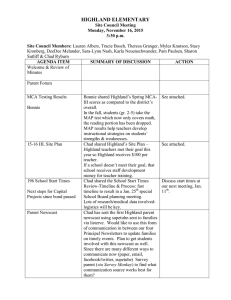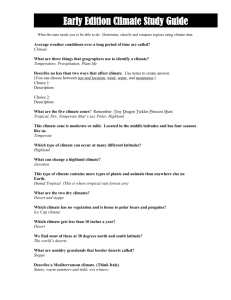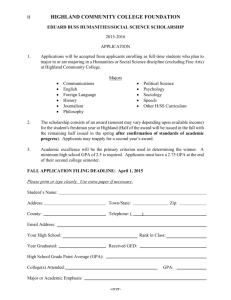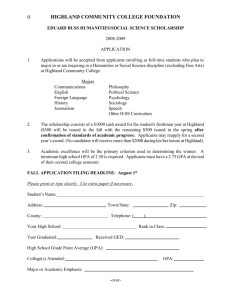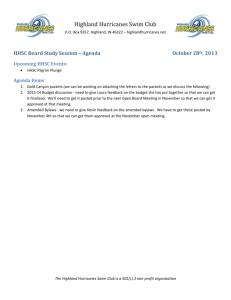Highland School of Technology Gaston County Schools Gastonia, North Carolina
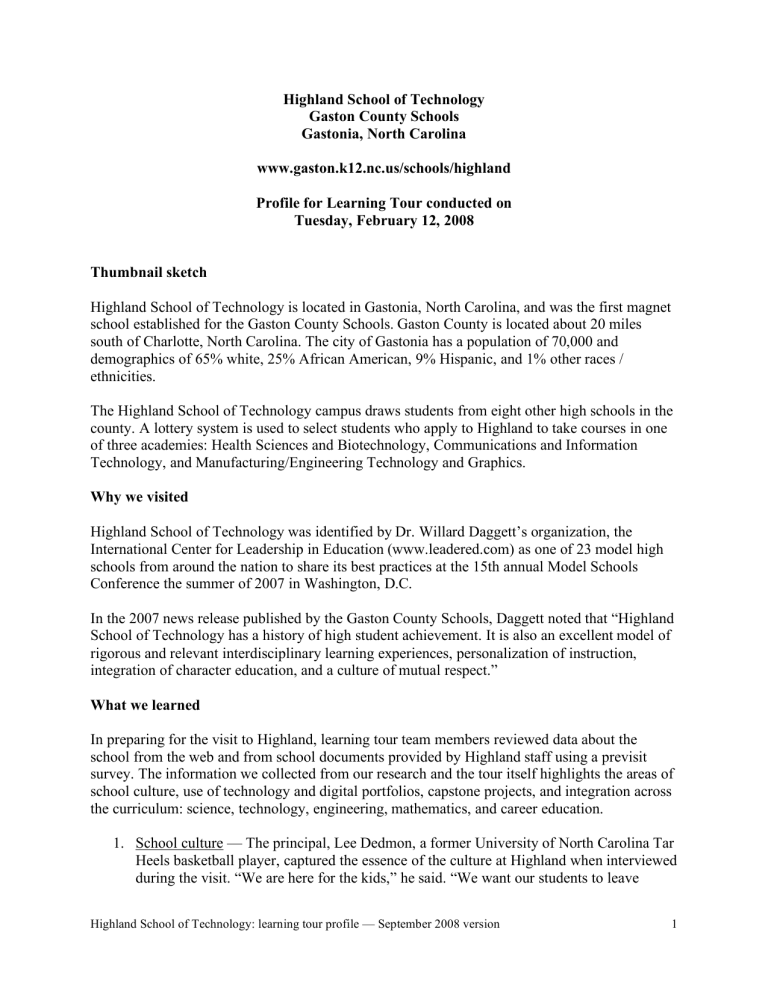
Highland School of Technology
Gaston County Schools
Gastonia, North Carolina www.gaston.k12.nc.us/schools/highland
Profile for Learning Tour conducted on
Tuesday, February 12, 2008
Thumbnail sketch
Highland School of Technology is located in Gastonia, North Carolina, and was the first magnet school established for the Gaston County Schools. Gaston County is located about 20 miles south of Charlotte, North Carolina. The city of Gastonia has a population of 70,000 and demographics of 65% white, 25% African American, 9% Hispanic, and 1% other races / ethnicities.
The Highland School of Technology campus draws students from eight other high schools in the county. A lottery system is used to select students who apply to Highland to take courses in one of three academies: Health Sciences and Biotechnology, Communications and Information
Technology, and Manufacturing/Engineering Technology and Graphics.
Why we visited
Highland School of Technology was identified by Dr. Willard Daggett’s organization, the
International Center for Leadership in Education (www.leadered.com) as one of 23 model high schools from around the nation to share its best practices at the 15th annual Model Schools
Conference the summer of 2007 in Washington, D.C.
In the 2007 news release published by the Gaston County Schools, Daggett noted that “Highland
School of Technology has a history of high student achievement. It is also an excellent model of rigorous and relevant interdisciplinary learning experiences, personalization of instruction, integration of character education, and a culture of mutual respect.”
What we learned
In preparing for the visit to Highland, learning tour team members reviewed data about the school from the web and from school documents provided by Highland staff using a previsit survey. The information we collected from our research and the tour itself highlights the areas of school culture, use of technology and digital portfolios, capstone projects, and integration across the curriculum: science, technology, engineering, mathematics, and career education.
1. School culture — The principal, Lee Dedmon, a former University of North Carolina Tar
Heels basketball player, captured the essence of the culture at Highland when interviewed during the visit. “We are here for the kids,” he said. “We want our students to leave
Highland School of Technology: learning tour profile — September 2008 version 1
Highland prepared to be successful — ready for college, ready for work, and ready for life.”
The school emphasizes a college-going culture. Throughout the school year, students participate in activities that support postsecondary goals — such as T-shirt day, mascot day, and ongoing conversations about university athletic rivalries.
Mr. Dedmon has installed a signpost that points to various colleges in the North Carolina area and out of state — including Texas A&M. Dr. Darlene Yañez, lead for this learning tour, noted that there was no marker to the University of Texas at Austin and Dedmon remarked, with a huge grin, “We will take care of that right away.”
Each academy takes pride in its students’ successful performance in the classroom and in their internships. Various employers from the area, including the fire department and manufacturers, hospitals, dentists, and retirement homes, provide opportunities for
Highland students to participate in substantive internships during their senior year.
The chief executive officers of a manufacturer and an engineering group sit on the
Highland High School of Technology advisory team. Mr. Dedmon noted that they bring
“a sense of reality and relevance to our academics.” The manufacturing CEO remarked,
“One of the best services we can offer kids is an understanding of the world of work so that they can figure out not only what they want to do but what they don’t want to do.”
Each academy has an associated club that students are strongly encouraged to join. The clubs include Health Occupations Students of America (HOSA), the Technology Student
Association, and Highland High School Robotics Team. Students participate in local, regional, and national competitions. Often, Highland students return from these competitions having placed within the top ten positions in the nation.
Justin Beam, academy coordinator for Health Sciences and Biotechnology, boasted about the team he will be taking to Texas to participate in the national Health Occupations
Students of America conference. “Our students come from a small community in North
Carolina but show up at the conference ready to compete with kids from all over the country,” he said. “They always bring to the competition a sense of pride and confidence that they will bring back first place.”
2. Use of technology and digital portfolios — Each academic and workforce development education classroom has no fewer than seven computers and two printers for student and teacher use. All computers are connected to a central server, and each student and teacher has his or her own password and email address. Each course’s curriculum highly recommends Internet use. Because the curriculum is integrated and project-based, technology use is necessary not only for the students but for the teachers as well.
Teachers meet as an integrated team and plan assignments and projects. Academic content and workforce development teachers create learning experiences that help students gain a rich understanding of their content and the relevance of the content.
Highland School of Technology: learning tour profile — September 2008 version 2
For example, integrating various subject matters and using technology, the economics teacher created a project for students to follow the stock market, and the mathematics teacher provided instruction for students on how to create predictor models based on the research the students collected from the web.
Another example, shared by the engineering/physics teacher, was a problem around electrical circuitry. The students documented their inquiry process using report-writing skills supported by their English teacher. At the end of both the stock market and the circuitry experiences, students archived their work and placed their projects on their webspace to use as a part of the digital portfolio presented during their senior year.
The digital portfolio plays a major role in each student’s school experience. Upon entering as a freshman, each student declares an academy pathway. During the first week of their freshman year, students are assigned logins and space on the campus’s server to upload all their work throughout their high school experiences.
The digital portfolios use Microsoft PowerPoint and Word programs. Students learn as freshmen how to use both these programs and build on their computer application skills.
Teachers in both the academic classes and the career classes help their students create portfolios that reflect the students’ experiences at Highland in a polished and professional format.
3. Capstone projects — As a senior capstone project, the students identify the projects, lessons, and other artifacts that best reflect their learning at Highland. The work they select represents a compilation of academic and career education that supports their capstone project. During the senior year, all students participate in an internship and tackle a problem that has to be solved using their knowledge and skills from school and their on-the-job responsibilities.
One student presenting his portfolio interned at the fire station. His career goal was to become a firefighter, and he was enrolled in the engineering pathway. He was assigned a project of testing materials used in the hoses on the fire engine and the water flow through the hoses. His portfolio presentation documented the entire inquiry process and his findings, as well as his academic experiences that supported his work at the fire station. “I came to Highland thinking I wanted to be an engineer,” he said, “but then, I got interested in working with the fire department. Even though my classes focused on engineering, I was able to use what I learned in those classes to help the fire department.”
4. Integration across the curriculum: science, technology, engineering, mathematics, and career education — Highland features an integrated approach to its curriculum. Each of the three learning academies has an academy coordinator and a team of teachers who are integrated across subjects. Together the teachers create lessons and learning experiences for students that integrate the curriculum of career courses and required specified standards created by the state of North Carolina. Teachers are expected to observe each others’ classes as well as the career courses. Examples of the integrated lesson plans can
Highland School of Technology: learning tour profile — September 2008 version 3
be accessed on the web at www.gaston.k12.nc.us/schools/highland/Integration_Plans/06-
07_Integration.htm.
Teaching and learning at the school is directed toward students working on projects and solving real-world problems. For example, the computer technology class was building computers from scratch, loading system files, and running batch files. Then, in turn, students used these computers in their academic classrooms to complete research and finish assignments.
The teacher content integration team meets once a week to discuss proposed assignments and projects in each class. They also meet one day every six weeks to plan and to write curriculum. Students observe that no class is a “silo,” and every class is related to the project that students are completing.
With each project, the emphasis shifts back and forth from academics to career education, but the skills students attain are continually reinforced by each of the team’s teachers.
One English teacher noted, “We are all responsible for each of our students. We can’t do it by ourselves, but together, we can make a difference in a student’s life. Not that we are
100% successful all the time, but we’re pretty close!”
The students’ success is reflected in student retention rates at Highland, which are more than 95 percent. Mr. Dedman pointed out that “if we can get the kids here as freshmen, they become part of the Highland family, and they stay.”
Who is Highland School of Technology?
Highland School of Technology’s mission
(www.gaston.k12.nc.us/schools/highland/AboutHST/AboutHST.htm), according to its website,
“is to prepare all students to be successful in postsecondary education, the community, and the workplace by providing each student with a rigorous and relevant academic, character, and technological education.” Highland School of Technology opened its doors in fall 2000 with a phase-in process that entailed enrolling 9th and 10th graders only and adding a new freshman class each subsequent year so that ultimately the school served grades 9–12. The school’s goal is that the total enrollment for all four grades will not exceed 600 students.
According to the school’s website
(www.gaston.k12.nc.us/schools/highland/AboutHST/AboutHST.htm), students eligible to enter the lottery to attend Highland must perform at or above grade level in reading and mathematics;
“have a 94% attendance rate; pass the 8th-grade computer competency test; have good standing in conduct in middle school; be a Gaston County resident; have filled out the Highland application form on or before the stated deadline.”
Highland School of Technology: learning tour profile — September 2008 version 4
Students:
The following 2007 student data was provided by the high school.
9th Grade: White African-American Hispanic
Other ethnic groups
Economically disadvantaged*
102 students 67% 25% 5% 3% 45%
*Percentage of students who are economically disadvantaged is determined by calculating the number of students participating in the federal free or reduced-price lunch program.
Instructional staff:
In 2007–08 Highland had 41 teachers, three academy coordinators, a principal, an assistant principal, and a guidance counselor. Other support staff included network administrators, a media specialist, a testing coordinator, and an athletic director.
The majority of the teachers recruited to Highland received their certification through alternative certification avenues. All the academy coordinators originated from the business community and now bring their real-world experience to the school.
Funding sources:
Highland High School is funded by the Gastonia County Schools as well as by the Bill and
Melinda Gates Foundation’s funds to support learning tours for educators and interested stakeholders. Local foundations and businesses — in particular, businesses that provide internships for seniors — have also contributed funds to support the programs and projects of
Highland.
Version 112408
Highland School of Technology: learning tour profile — September 2008 version 5
